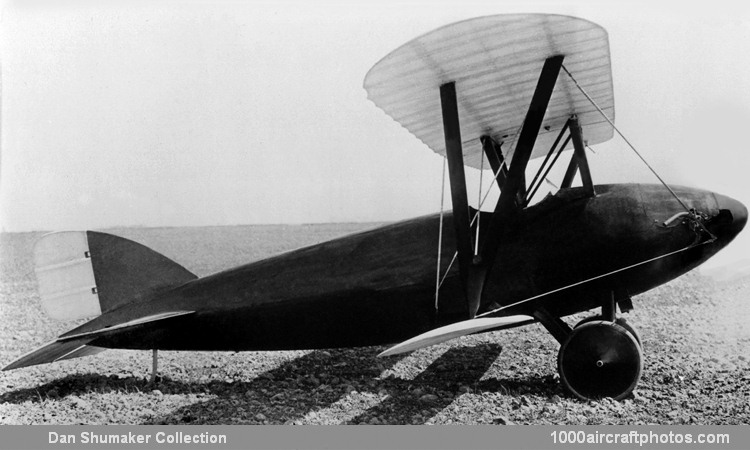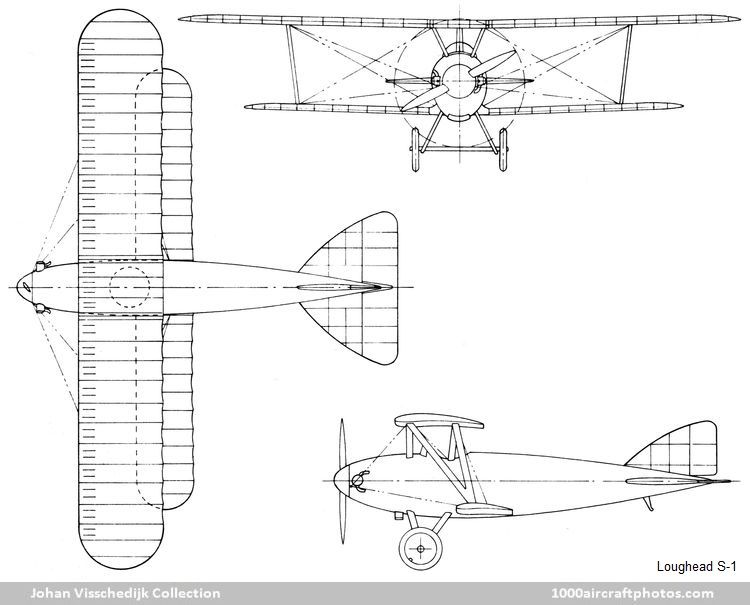Seeking to capture a share of the market for private aircraft which was anticipated to result from the return of wartime pilots to civil life, Loughead and Northrop, assisted by Tony Stadlman, conceived in 1919 a light single-bay biplane. Its design incorporated several novel features including manually folded wings to ease ground transport and facilitate storage in a garage. For lateral control the aircraft used neither ailerons nor wing-warping but its entire lower wing surfaces could change angle differentially on a fuselage pivot point. Furthermore, to reduce landing speed both halves of the lower wing could be rotated simultaneously on this pivot point to act as air brakes.
Even more remarkable was its fuselage construction, with two plywood half-shells glued on concentric wooden circles. These shells were obtained by placing in a specially built, full length concrete tub three thicknesses of spruce plywood, with the grain laid alternatively, and coated with casein glue. To achieve adequate bonding and proper shaping, a rubber bag was inserted in the tub and, after a cover had been clamped over, was inflated to a pressure of 20 lb/sq.in (1.4 kg/sq.cm). After twenty-four hours, the 0.5 in (3 mm) thick shells were ready for installation, with longitudinal seams above and beneath the fuselage. The result was a very clean body combining light weight with ample strength.
As no adequate powerplants were readily available – plans to use the British built Green engine foundered when its manufacturer went out of business – Loughead drew up the desired specification and Stadlman designed the Loughead XL-1 two-cylinder, horizontally-opposed, liquid-cooled engine developing 25 hp at 1,800 rpm. With this engine driving a two-blade Paragon propeller the S-1 was first flown at Redwood City, California, in late 1919 or early 1920, by Gilbert C. Budwig. It immediately demonstrated good handling characteristics and, after the installation of a propeller also designed by Stadlman, good performance with a top speed of 70 mph (113 kmh) and landing speed of only 25 mph (40 kmh), even without the use of the lower wing as an air-brake.
Unfortunately for Loughead and his team, the single-seat S-1, after being demonstrated over much of California and gaining the attention of such noted aviators as Lieutenant H.H. Arnold – who was to become Chief of the Army Air Forces – failed to attract customers as its purchase price far exceeded that of brand-new two-seat Curtiss Jennies sold as surplus at a unit price as low as $350. A quarter of a century later the Lockheed Aircraft Corporation had to learn the same lesson when the higher acquisition price of its Saturn and Little Dipper could not be offset by their operating costs, even though substantially lower than those of surplus aircraft.
After investing $29,800 in its S-1 sports biplane the Loughead Aircraft Manufacturing Company at Santa Barbara, California was forced to go out of business in 1921. Six years later, however, the S-1 construction method resurfaced in the Vega, the first aircraft to bear the Lockheed name."
Span: upper 28 ft 0 in (8.53 m)
Span: lower 24 ft 0 in (7.32 m)
Length: 20 ft 0 in (6.10 m)
Height: 7 ft 3 in (2.21 m)
Empty weight: 375 lb (170 kg)
Loaded weight: 825 lb (374 kg)
Fuel: 8 gal (30 l)
Power loading: 33 lb/hp (15 kg/hp)
Max speed: 70 mph (113 kmh)
Climb: 700 ft/min (213 m/min)
Service ceiling: 12,000 ft (3,658 m)
Endurance: 8 hr

